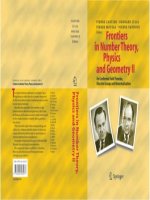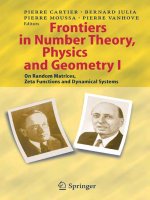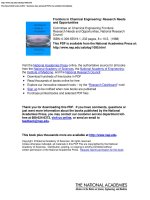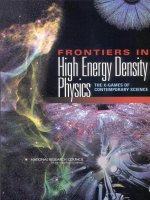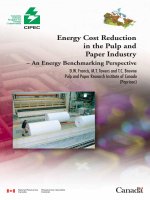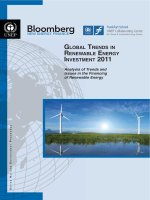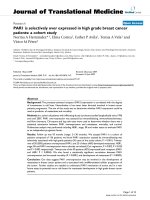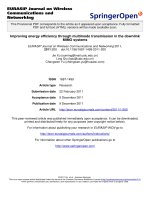- Trang chủ >>
- Khoa Học Tự Nhiên >>
- Vật lý
FRONTIERS IN High Energy Density Physics docx
Bạn đang xem bản rút gọn của tài liệu. Xem và tải ngay bản đầy đủ của tài liệu tại đây (5.48 MB, 176 trang )
Committee on High Energy Density Plasma Physics
Plasma Science Committee
Board on Physics and Astronomy
Division on Engineering and Physical Sciences
THE NATIONAL ACADEMIES PRESS
Washington, D.C.
www.nap.edu
FRONTIERS IN
High Energy Density
Physics
THE X-GAMES OF
CONTEMPORARY SCIENCE
THE NATIONAL ACADEMIES PRESS 500 Fifth Street, N.W. Washington, DC 20001
NOTICE: The project that is the subject of this report was approved by the Governing Board
of the National Research Council, whose members are drawn from the councils of the
National Academy of Sciences, the National Academy of Engineering, and the Institute of
Medicine. The members of the committee responsible for the report were chosen for their
special competences and with regard for appropriate balance.
This project was supported by the Department of Energy under Award No. DE-FG20-
00ER54612. Any opinions, findings, conclusions, or recommendations expressed in this
publication are those of the author(s) and do not necessarily reflect the views of the sponsors.
Front Cover:
Background image: Hubble Space Telescope image of the Cygnus Loop—the
shock wave from a 20,000-year-old supernova in the constellation of Cygnus. Courtesy of
NASA. Inset images: the Z-Machine, courtesy of Sandia National Laboratories; the OMEGA
laser, courtesy of the Laboratory for Laser Energetics, University of Rochester; and results from
the first gold-on-gold collision experiments at the Relativisitic Heavy Ion Collider, courtesy of
Brookhaven National Laboratory.
Back Cover:
The target chamber at the National Ignition Facility, courtesy of Lawrence
Livermore National Laboratory; and three-dimensional PIC simulation of a plasma wakefield
accelerator, courtesy of R. Fonseca, Instituto Superior Técnico of Portugal, and the E-162
collaboration.
Library of Congress Control Number 2003103684
International Standard Book Number 0-309-08637-X
Additional copies of this report are available from:
The National Academies Press, 500 Fifth Street, N.W., Washington, DC 20001; (800) 624-
6242 or (202) 334-3313 (in the Washington metropolitan area); Internet <http://
www.nap.edu>; and the Board on Physics and Astronomy, National Research Council, 500
Fifth Street, N.W., Washington, DC 20001; Internet < />bpa>.
Copyright 2003 by the National Academy of Sciences. All rights reserved.
Printed in the United States of America
The National Academy of Sciences is a private, nonprofit, self-perpetuating society of distin-
guished scholars engaged in scientific and engineering research, dedicated to the furtherance
of science and technology and to their use for the general welfare. Upon the authority of the
charter granted to it by the Congress in 1863, the Academy has a mandate that requires it to
advise the federal government on scientific and technical matters. Dr. Bruce M. Alberts is
president of the National Academy of Sciences.
The National Academy of Engineering was established in 1964, under the charter of the
National Academy of Sciences, as a parallel organization of outstanding engineers. It is
autonomous in its administration and in the selection of its members, sharing with the National
Academy of Sciences the responsibility for advising the federal government. The National
Academy of Engineering also sponsors engineering programs aimed at meeting national
needs, encourages education and research, and recognizes the superior achievements of
engineers. Dr. Wm. A. Wulf is president of the National Academy of Engineering.
The Institute of Medicine was established in 1970 by the National Academy of Sciences to
secure the services of eminent members of appropriate professions in the examination of
policy matters pertaining to the health of the public. The Institute acts under the responsibility
given to the National Academy of Sciences by its congressional charter to be an adviser to the
federal government and, upon its own initiative, to identify issues of medical care, research,
and education. Dr. Harvey V. Fineberg is president of the Institute of Medicine.
The National Research Council was organized by the National Academy of Sciences in 1916
to associate the broad community of science and technology with the Academy’s purposes of
furthering knowledge and advising the federal government. Functioning in accordance with
general policies determined by the Academy, the Council has become the principal operating
agency of both the National Academy of Sciences and the National Academy of Engineering
in providing services to the government, the public, and the scientific and engineering com-
munities. The Council is administered jointly by both Academies and the Institute of Medicine.
Dr. Bruce M. Alberts and Dr. Wm. A. Wulf are chair and vice chair, respectively, of the
National Research Council.
www.national-academies.org
v
COMMITTEE ON HIGH ENERGY DENSITY PLASMA PHYSICS
RONALD C. DAVIDSON, Princeton University, Chair
DAVID ARNETT, University of Arizona
JILL DAHLBURG, General Atomics
PAUL DIMOTAKIS, California Institute of Technology
DANIEL DUBIN, University of California, San Diego
GERALD GABRIELSE, Harvard University
DAVID HAMMER, Cornell University
THOMAS KATSOULEAS, University of Southern California
WILLIAM KRUER, Lawrence Livermore National Laboratory
RICHARD LOVELACE, Cornell University
DAVID MEYERHOFER, University of Rochester
BRUCE REMINGTON, Lawrence Livermore National Laboratory
ROBERT ROSNER, University of Chicago
ANDREW SESSLER, Lawrence Berkeley National Laboratory
PHILLIP SPRANGLE, Naval Research Laboratory
ALAN TODD, Advanced Energy Systems
JONATHAN WURTELE, University of California, Berkeley
Staff
DONALD C. SHAPERO, Director
MICHAEL H. MOLONEY, Study Director (from September 2001)
ACHILLES D. SPELIOTOPOULOS, Study Director (November 2000-September
2001)
CYRA A. CHOUDHURY, Project Associate
PAMELA A. LEWIS, Project Associate
NELSON QUIÑONES, Project Assistant
vi
PLASMA SCIENCE COMMITTEE
THOMAS M. O’NEIL, University of California, San Diego, Chair
MICHAEL S. BARNES, Applied Materials
ALLEN BOOZER, Columbia University
JOHN CARY, University of Colorado, Boulder
CYNTHIA A. CATTELL, University of Minnesota
CARY FOREST, University of Wisconsin, Madison
WALTER GEKELMAN, University of California, Los Angeles
MARK J. KUSHNER, University of Illinois at Urbana-Champaign
DAVID MEYERHOFER, University of Rochester
CLAUDIO PELLEGRINI, University of California, Los Angeles
DMITRI RYUTOV, Lawrence Livermore National Laboratory
STEWART J. ZWEBEN, Princeton University
Staff
DONALD C. SHAPERO, Director
MICHAEL H. MOLONEY, Program Officer
TIMOTHY I. MEYER, Research Associate
PAMELA A. LEWIS, Project Associate
NELSON QUIÑONES, Project Assistant
vii
BOARD ON PHYSICS AND ASTRONOMY
JOHN P. HUCHRA, Harvard-Smithsonian Center for Astrophysics, Chair
ROBERT C. RICHARDSON, Cornell University, Vice Chair
JONATHAN BAGGER, Johns Hopkins University
GORDON A. BAYM, University of Illinois at Urbana-Champaign
CLAUDE R. CANIZARES, Massachusetts Institute of Technology
WILLIAM EATON, National Institutes of Health
WENDY L. FREEDMAN, Carnegie Observatories
FRANCES HELLMAN, University of California, San Diego
KATHRYN LEVIN, University of Chicago
CHUAN SHENG LIU, University of Maryland
LINDA J. (LEE) MAGID, University of Tennessee at Knoxville
THOMAS M. O’NEIL, University of California, San Diego
JULIA M. PHILLIPS, Sandia National Laboratories
BURTON RICHTER, Stanford University
ANNEILA I. SARGENT, California Institute of Technology
JOSEPH H. TAYLOR, JR., Princeton University
THOMAS N. THEIS, IBM Thomas J. Watson Research Center
CARL E. WIEMAN, University of Colorado/JILA
Staff
DONALD C. SHAPERO, Director
ROBERT L. RIEMER, Senior Program Officer
MICHAEL H. MOLONEY, Program Officer
BRIAN DEWHURST, Research Associate
TIMOTHY I. MEYER, Research Associate
PAMELA A. LEWIS, Project Associate
NELSON QUIÑONES, Project Assistant
VAN AN, Financial Associate
ix
Preface
The Committee on High Energy Density Plasma Physics was established in April
2001 by the National Research Council’s (NRC’s) Board on Physics and Astronomy
to identify scientific opportunities and develop a unifying theme for research on
matter under extreme high energy density conditions. Specifically, the committee
was charged with the following tasks: (a) to review recent advances in the field of
high energy density plasma phenomena, on both the laboratory scale and the astro-
physical scale; (b) to provide a scientific assessment of the field, identifying
compelling research opportunities and intellectual challenges; (c) to develop a
unifying framework for diverse aspects of the field; (d) to outline a strategy for
extending the forefronts of the field through scientific experiments at various facilities
where high energy density plasmas can be created; and (e) to discuss the roles of
national laboratories, universities, and industry in achieving these objectives.
While this is a challenging set of tasks, the committee recognizes that now is a
highly opportune time for the nation’s scientists to develop a fundamental under-
standing of the physics of high energy density plasmas. The space-based and ground-
based instruments for measuring astrophysical processes under extreme conditions
are unprecedented in their accuracy and detail. In addition, a new generation of
sophisticated laboratory systems (“drivers”), now existing or planned, creates matter
under extreme high energy density conditions (exceeding 10
11
J/m
3
), permitting the
detailed exploration of physical phenomena under conditions not unlike those in
astrophysical systems. High energy density experiments span a wide range of areas
of physics including plasma physics, materials science and condensed matter
x Preface
physics, nuclear physics, atomic and molecular physics, fluid dynamics and
magnetohydrodynamics, and astrophysics. While a number of scientific areas are
represented in high energy density physics, many of the high energy density research
techniques have grown out of ongoing research in plasma science, astrophysics,
beam physics, accelerator physics, magnetic fusion, inertial confinement fusion,
and nuclear weapons research. The intellectual challenge of high energy density
physics lies in the complexity and nonlinearity of the collective interaction processes.
Several important findings became apparent during the committee’s delibera-
tions; they are detailed in the report. Two key findings are mentioned here. First, a
consensus is emerging in the plasma physics and astrophysics communities that
many opportunities exist for significant advances in understanding the physics of
high energy density plasmas through an integrated approach to investigating the
scientific issues in related subfields. Understanding the physics of high energy
density plasmas will also lead to new applications and will benefit other areas of
science. Furthermore, learning to control and manipulate high energy density
plasmas in the laboratory will benefit national programs, such as inertial confine-
ment fusion and the stockpile stewardship program, through the development of
new ideas and the training of a new generation of scientists and engineers.
Second, the committee is convinced that research opportunities in this cross-
cutting area of physics are of the highest intellectual caliber and are fully deserving
of consideration of support by the leading funding agencies of the physical sciences.
A broad federal support base for research in high energy density physics, including
plasma science, and the encouragement of interagency research initiatives in this
interdisciplinary field would greatly strengthen the ability of the nation’s universities
to have a significant impact on this exciting field of physics.
The committee was very proactive in collecting information for its deliberations,
meeting frequently by conference call and through electronic communication and
engaging the scientific community through several professional society mailings,
expert briefings of the committee, and site visits, and through a “town meeting” held
at the October 2001 annual meeting of the Division of Plasma Physics of the
American Physical Society in Long Beach, California. The full committee met on
three occasions after its formation in April 2001—on May 11–12, 2001, in Washing-
ton, D.C.; on November 2–4, 2001, in Irvine, California; and at a final meeting on
March 15–16, 2002, in Washington, D.C.
During this assessment, the committee received the encouragement, support,
and expert counsel of many individuals to whom it is indebted, including Christopher
Keane of the National Nuclear Security Administration; Ronald McKnight of the
Department of Energy’s Office of Fusion Energy Sciences; Tom O’Neil and the
NRC’s Plasma Science Committee; and Michael Moloney, Achilles Speliotopoulos,
and Donald Shapero of the National Research Council. The committee is also
Preface xi
grateful to the following physicists who made important scientific contributions to
the preparation of this report: Jonathan Aarons, Bedros Afeyan, Yefim Aglitskiy,
William Barletta, Christopher Barty, Gordon Baym, Richard Berger, Gennadii
Bisnovatyi-Kogan, Roger Blandford, Deborah Callahan-Miller, Michael Campbell,
Pisin Chen, Stirling Colgate, Christopher Deeney, Todd Ditmire, Jonathan Dorfan,
Paul Drake, Jim Dunn, Fred Dylla, Juan Fernandez, Nathaniel Fisch, Alex Friedman,
Siegfried Glenzer, Daniel Goodin, Michael Harrison, Stephen Hatchett, Alan Hauer,
Mark Hogan, Zhirong Huang, Chan Joshi, Alexander Koldoba, Glenn Kubiak, Dong
Lai, Otto Landen, Richard Lee, Wim Leemans, Hui Li, Edison Liang, Steve Libby,
Grant Logan, Dennis Matthews, Keith Matzen, Robert McCrory, Dan Meiron, Paul
Messina, Peter Meszaros, George Miller, Warren Mori, Gerard Mourou, Johnny Ng,
Stephen Obenschain, Marina Romanova, Francesco Ruggiero, Jack Shlachter,
Gennady Shvets, Richard Siemon, Richard Sluten, Paul Springer, Richard Stephens,
David Stevenson, James Stone, Galia Ustyugova, Bruce Warner, Ira Wasserman,
Bernard Wilde, Alan Wootton, Craig Wuest, and Sasha Zholents.
Additional thanks go to the following individuals, who made an important
contribution through the provision of images for inclusion in this report: James
Bailey, John Biretta, Kimberly Budil, Robert Cauble, Gilbert Collins, David Farley,
Nathaniel Fisch, John Foster, Miguel Furman, Peter Garnavich, Gail Glendinning,
Jacob Grun, Walter Jaffe, William Junor, Konstantinos Kifonidis, Manooch
Koochesfahani, Christine Labaune, Sergey Lebedev, Mario Livio, Andrew
Mackinnon, Vladimir Malkin, Stephen Obenschain, David Reis, Yasuhiko Sentoku,
Bert Still, Hugh Van Horn, Shuoqin Wang, Craig West, Scott Wilks, Stanford
Woosley, and Simon Yu.
In formulating its findings and recommendations, the committee benefited from
extensive discussions with members of the scientific community. The committee
was charged with assessing the current status of high energy density physics and
identifying the compelling research opportunities. While key facilities and facility
upgrades for carrying out this research are identified in the report, the establishment
of priorities and ranking of facilities were beyond the committee’s charge, but
certainly merit a future study.
The reader should note that the committee made the decision early on in the
drafting of this report not to include references except for the sources of figures. The
committee believed that a partial listing would not be appropriate.
On a personal note, I would like to express my sincere appreciation to all
members of the committee for the conscientious efforts that they have devoted to
this important study, particularly to David Meyerhofer and Bruce Remington for
leading the preparation of the chapter on high energy density laboratory plasmas; to
Bob Rosner and David Arnett for the chapter on high energy density astrophysical
systems; to Tom Katsouleas and Phillip Sprangle for the chapter on laser-plasma and
xii Preface
beam-plasma interactions; and to David Hammer for his critical proofreading of the
final draft report.
On behalf of the committee, I would also like to express our appreciation to
Michael Turner and the NRC’s Committee on the Physics of the Universe (CPU) for
recognizing the important role of high energy density physics in their seminal assess-
ment of the key questions and research opportunities at the intersection of physics
and astronomy.
1
This committee is particularly gratified that the CPU report identifies
the important role that laboratory facilities, such as high-power lasers and high-
energy accelerators, can play in simulating the conditions that govern extreme
astrophysical environments, ranging from gamma-ray bursts to quark-gluon plasmas
in the early universe.
In conclusion, the committee believes that now is a very opportune time to
make major advances in the physics of understanding matter under extreme high
energy density conditions. A sustained commitment by the federal government, the
national laboratories, and the university community to answer the questions of high
intellectual value identified by the committee and to implement the recommenda-
tions of this report will contribute significantly to the timely realization of these
exciting research opportunities and the advancement of this important field of
physics.
Ronald C. Davidson, Chair
Committee on High Energy Density Plasma Physics
1
National Research Council, Connecting Quarks with the Cosmos: Eleven Science Questions for the
New Century, Committee on the Physics of the Universe, The National Academies Press, Washington,
D.C., 2003.
xiii
Acknowledgment of Reviewers
This report has been reviewed in draft form by individuals chosen for their
diverse perspectives and technical expertise, in accordance with procedures
approved by the National Research Council’s Report Review Committee. The
purpose of this independent review is to provide candid and critical comments that
will assist the institution in making its published report as sound as possible and to
ensure that the report meets institutional standards for objectivity, evidence, and
responsiveness to the study charge. The review comments and draft manuscript
remain confidential to protect the integrity of the deliberative process. We wish to
thank the following individuals for their review of this report:
Roger D. Blandford, California Institute of Technology,
Michael Campbell, General Atomics,
Walter Gekelman, University of California, Los Angeles,
Alice Harding, NASA Goddard Space Flight Center,
Gerard A. Mourou, University of Michigan,
Julia M. Phillips, Sandia National Laboratories,
Dmitri Ryutov, Lawrence Livermore National Laboratory, and
Robert H. Siemann, Stanford University.
Although the reviewers listed above have provided many constructive comments
and suggestions, they were not asked to endorse the conclusions or recommenda-
xiv Acknowledgment of Reviewers
tions, nor did they see the final draft of the report before its release. The review of
this report was overseen by Clifford Surko, University of California, San Diego.
Appointed by the National Research Council, he was responsible for making certain
that an independent examination of this report was carried out in accordance with
institutional procedures and that all review comments were carefully considered.
Responsibility for the final content of this report rests entirely with the authoring
committee and the institution.
xvi Contents
Applications, 96
Opportunities for Generating and Utilizing High Energy Density
Conditions in the Laboratory, 100
4 LASER-PLASMA AND BEAM-PLASMA INTERACTIONS 120
Introduction, 120
Questions, 121
High Energy Density Beam-Plasma Physics: Phenomena, 122
High Energy Density Beam-Plasma Physics: Applications, 125
Opportunities, 139
GLOSSARY 149
1
Executive Summary
BACKGROUND
Recent advances in extending the energy, power, and brightness of lasers, par-
ticle beams, and Z-pinch generators make it possible to create matter with extremely
high energy density in the laboratory. The collective interaction of this matter with
itself, particle beams, and radiation fields is a rich, expanding field of physics called
high energy density physics. It is a field characterized by extreme states of matter
previously unattainable in laboratory experiments. It is also a field rich in new
physics phenomena and compelling applications, propelled by advances in high-
performance computing and advanced measuring techniques. This report’s working
definition of “high energy density” refers to energy densities exceeding 10
11
joules
per cubic meter (J/m
3
), or equivalently, pressures exceeding 1 megabar (Mbar). (For
example, the energy density of a hydrogen molecule and the bulk moduli of solid
materials are about 10
11
J/m
3
.)
The time is highly opportune for the nation’s scientists to develop a fundamental
understanding of the physics of high energy density plasmas. The space-based and
ground-based instruments for measuring astrophysical processes under extreme con-
ditions are unprecedented in their accuracy and detail, revealing a universe of
colossal agitation and tempestuous change. In addition, there is a new generation of
sophisticated laboratory systems (“drivers”), existing or planned, that creates matter
under extreme high energy density conditions, permitting the detailed exploration of
physics phenomena under conditions not unlike those in astrophysical systems.
2 Frontiers in High Energy Density Physics
A consensus is emerging in the plasma physics and astrophysics communities
that many opportunities exist for significant advances in understanding the physics
of high energy density plasmas through an integrated approach to investigating the
scientific issues in related subfields. Understanding the physics of high energy
density plasmas will also lead to new applications and benefit other areas of science.
Learning to control and manipulate these plasmas in the laboratory will benefit
national programs, such as inertial confinement fusion and the stockpile steward-
ship program, through the development of new ideas and the training of a new
generation of scientists and engineers. Furthermore, advanced technologies in the
areas of high-speed instrumentation, optics (including x-ray optics), high-power
lasers, advanced pulse power, and microfabrication techniques can be expected to
lead to important spin-offs.
High energy density experiments span a wide range of areas of physics includ-
ing plasma physics, laser and particle beam physics, materials science and
condensed matter physics, nuclear physics, atomic and molecular physics, fluid
dynamics and magnetohydrodynamics, intense radiation-matter interaction, and
astrophysics. While a number of scientific areas are represented in high energy
density physics, many high energy density research techniques have grown out of
ongoing work in plasma science, astrophysics, beam physics, accelerator physics,
magnetic fusion, inertial confinement fusion, and nuclear weapons research. The
intellectual challenge of high energy density physics lies in the complexity and
nonlinearity of the collective interaction processes that characterize all of these
subfields of physics.
It should be emphasized that while high energy density physics is a rapidly
developing area of research abroad, particularly in Europe and Japan, the primary
focus of this report is on assessing the present capabilities and compelling research
opportunities in the United States.
To illustrate the energy scale of the high energy density regime, some of the
systems that deliver the energy in high energy density laboratory experiments in the
United States can be considered. Typical state-of-the-art short-pulse lasers and the
electron beams generated at the Stanford Linear Accelerator Center can be focused
to deliver 10
20
watts per square centimeter (W/cm
2
) on target. The present genera-
tion of lasers employed in inertial confinement fusion (on the NIKE facility at the
Naval Research Laboratory, on OMEGA at the Laboratory for Laser Energetics at the
University of Rochester, and at the TRIDENT laser laboratory at Los Alamos National
Laboratory) deliver 1 to 40 kilojoules (kJ) to a few cubic millimeters volume in a few
nanoseconds. In Z-pinch experiments on the Z-machine at Sandia National Labora-
tories, 1.8 megajoules (MJ) of soft x rays are delivered to a few cubic centimeters
volume in about 5 to 15 nanoseconds (ns). With the planned upgrades of existing
facilities and the completion of the National Ignition Facility (NIF) at the Lawrence
Executive Summary 3
Livermore National Laboratory in the early 2000s, the parameter range of high
energy density physics phenomena that can be explored will expand significantly.
Complementary technologies, such as gas guns, explosively driven experiments,
and diamond anvils, can also generate physically interesting high energy density
physics conditions in the laboratory. While the primary purpose of the major
facilities sponsored by the Department of Energy’s National Nuclear Security
Administration (NNSA) is to investigate technical issues related to stockpile steward-
ship and inertial confinement fusion, increasing opportunities on these facilities are
also available for exploring the basic aspects of high energy density physics. These
state-of-the-art facilities allow repeatable experiments and controlled parameter
variations to elucidate the important underlying physics.
Elucidating the physics of high energy density plasmas through experiment,
theory, and numerical simulation presents exciting science opportunities for under-
standing physical phenomena in laboratory-generated high energy density plasmas
and in astrophysical systems. Because the field is developing rapidly, a study of the
compelling research opportunities and synergies in high energy density plasma
physics and its related subfields is particularly pertinent at the present time.
ASSESSING THE FIELD
In carrying out this assessment, the National Research Council’s Committee on
High Energy Density Plasma Physics found high energy density physics (pressure
conditions exceeding 1 Mbar, say) to be a rapidly growing field of physics with
exciting research opportunities of high intellectual challenge spanning a wide range
of physics areas. Opportunities for exploring the compelling questions of the field
have never been more numerous. The many excellent high energy density facilities—
together with a new generation of sophisticated diagnostic instruments, existing or
planned, that can measure properties of matter under extreme high energy density
conditions—permit laboratory exploration of many aspects of high energy density
physics phenomena in exquisite detail under conditions of considerable interest for
the following: basic high energy density physics studies, materials research, under-
standing astrophysical processes, commercial applications (e.g., extreme ultraviolet
lithography), inertial confinement fusion, and nuclear weapons research.
Furthermore, a revolution in computational capabilities has brought physical
phenomena within the scope of numerical simulations that were out of reach only a
few years ago. Numerical modeling is now possible for many aspects of the complex
nonlinear dynamics and collective processes characteristic of high energy density
laboratory plasmas and for the extreme hydrodynamic motions that exist under
astrophysical conditions. The first phase of advanced computations at massively
parallel facilities such as those developed in the Advanced Strategic Computing
4 Frontiers in High Energy Density Physics
Initiative (ASCI) is reaching fruition with remarkable achievements, and a unique
opportunity exists at this time to integrate theory, experimentation, and advanced
computations to significantly advance the fundamental understanding of high energy
density plasmas.
Exciting new discoveries in astrophysics have occurred along with dramatic
improvements in measurements by ground-based and space-based instruments of
astrophysical processes under extreme high energy density conditions. Using the
new generation of laboratory high energy density facilities, macroscopic collections
of matter can be created under astrophysically relevant conditions, providing critical
data on hydrodynamic mixing, shock phenomena, radiation flow, complex opaci-
ties, high-Mach-number jets, equations of state, relativistic plasmas, and possibly,
quark-gluon plasmas characteristic of the early universe.
A highly cost-effective way of significantly extending the frontiers of high energy
density physics research is to upgrade and/or modify existing and planned experi-
mental facilities to access new operating regimes. Such upgrades and modifications
of experimental facilities will open up exciting research opportunities beyond those
which are accessible with existing and planned laboratory systems. These opportu-
nities range, for example, from the installation of ultrahigh-intensity (petawatt) lasers
on inertial confinement fusion facilities to create relativistic plasma conditions
relevant to gamma-ray bursts and neutron star atmospheres, to the installation of
dedicated beamlines on high energy physics accelerator facilities for carrying out
basic high energy density physics studies, such as the development of ultrahigh-
gradient acceleration concepts and unique radiation sources extending from the
infrared to gamma-ray regimes.
In reviewing the level of support for research on high energy density physics
provided by federal program agencies, the committee found that the level of support
by agencies such as the NNSA, the nondefense directorates in the Department of
Energy, the National Science Foundation, the Department of Defense, and the
National Aeronautics and Space Administration has lagged behind the scientific
imperatives and compelling research opportunities offered by this exciting field of
physics. The NNSA’s establishment of the Stewardship Science Academic Alliances
program to fund research projects at universities in areas of fundamental high energy
density science and technology relevant to stockpile stewardship is commendable
and important, particularly because the nation’s universities represent a vast resource
for developing and testing innovative ideas in high energy density physics and for
training graduate students and postdoctoral research associates.
The committee is convinced that research opportunities in this crosscutting area
of physics are of the highest intellectual caliber and that they are fully deserving of
the consideration of support by the leading funding agencies of the physical sciences.
A broad federal support base for research in high energy density physics, including
Executive Summary 5
plasma science, and the encouragement of interagency research initiatives in this
very interdisciplinary field would greatly strengthen the ability of the nation’s
universities to have a significant impact on this field.
THE KEY QUESTIONS
In developing a unifying framework for the diverse areas of high energy density
physics and identifying research opportunities of high intellectual value, the com-
mittee found it useful to formulate key scientific questions ranging from the very
basic physics questions to those at the frontier of the field. These are questions that,
if answered, would have a profound effect on our understanding of the fundamental
physics of matter under high energy density conditions. The following list of
questions is not intended to be complete but rather to be illustrative of important
questions of high intellectual value in high energy density physics:
• How does matter behave under conditions of extreme temperature, pressure,
density, and electromagnetic fields?
• What are the opacities of stellar matter?
• What is the nature of matter at the beginning of the universe?
• How does matter interact with photons and neutrinos under extreme
conditions?
• What is the origin of intermediate-mass and high-mass nuclei in the universe?
• Can nuclear flames (ignition and propagating burn) be created in the
laboratory?
• Can high-yield ignition in the laboratory be used to study aspects of super-
novae physics, including the generation of high-Z elements?
• Can the mechanisms for formation of astrophysical jets be simulated in
laboratory experiments?
• Can the transition to turbulence, and the turbulent state, in high energy
density systems be understood experimentally and theoretically?
• What are the dynamics of the interaction of strong shocks with turbulent and
inhomogeneous media?
• Will measurements of the equation of state and opacity of materials at high
temperatures and pressures change models of stellar and planetary structure?
• Can electron-positron plasmas relevant to gamma-ray bursts be created in
the laboratory?
• Can focused lasers “boil the vacuum” to produce electron-positron pairs?
• Can macroscopic amounts of relativistic matter be created in the laboratory
and will it exhibit fundamentally new collective behavior?
6 Frontiers in High Energy Density Physics
• Can we predict the nonlinear optics of unstable multiple and interacting
beamlets of intense light or matter as they filament, braid, and scatter?
• Can the ultraintense field of a plasma wake be used to make an ultrahigh-
gradient accelerator with the luminosity and beam quality needed for appli-
cations in high energy and nuclear physics?
• Can high energy density beam-plasma interactions lead to novel radiation
sources?
These questions cut across the boundaries of this field, and answering them will
require new approaches to building a comprehensive strategy for realizing the excit-
ing research opportunities. With this in mind the committee makes the following
recommendations.
RECOMMENDATIONS
a. Recommendation on external user experiments at major facilities
It is recommended that the National Nuclear Security Administration con-
tinue to strengthen its support for external user experiments on its major high
energy density facilities, with a goal of about 15 percent of facility operating
time dedicated to basic physics studies. This effort should include the imple-
mentation of mechanisms for providing experimental run time to users, as
well as providing adequate resources for operating these experiments,
including target fabrication, diagnostics, and so on. A major limitation of
present mechanisms is the difficulty in obtaining complex targets for user
experiments.
b. Recommendation on the Stewardship Science Academic Alliances program
It is recommended that the National Nuclear Security Administration con-
tinue and expand its Stewardship Science Academic Alliances program to
fund research projects at universities in areas of fundamental high energy
density science and technology. Universities develop innovative concepts
and train the graduate students who will become the lifeblood of the nation’s
research in high energy density physics. A significant effort should also be
made by the federal government and the university community to expand the
involvement of other funding agencies, such as the National Science Founda-
tion, the National Aeronautics and Space Administration, the Department of
Defense, and the nondefense directorates in the Department of Energy, in
supporting research of high intellectual value in high energy density physics.
Executive Summary 7
c. Recommendation on maximizing the capabilities of facilities
A significant investment is recommended in advanced infrastructure at major
high energy density facilities for the express purpose of exploring research
opportunities for new high energy density physics. This effort is intended to
include upgrades, modifications, and additional diagnostics that enable new
physics discoveries outside the mission for which the facility was built. Joint
support for such initiatives is encouraged from agencies with an interest in
funding users of the facility as well as from the primary program agency
responsible for the facility.
d. Recommendation on the support of university research
It is recommended that significant federal resources be devoted to support-
ing high energy density physics research at university-scale facilities, both
experimental and computational. Imaginative research and diagnostic devel-
opment on university-scale facilities can lead to new concepts and instru-
mentation techniques that significantly advance our understanding of high
energy density physics phenomena and in turn are implemented on state-of-
the-art facilities.
e. Recommendation on a coordinated program of computational-experimental
integration
It is recommended that a focused national effort be implemented in support
of an iterative computational-experimental integration procedure for investi-
gating high energy density physics phenomena.
f. Recommendation on university and national laboratory collaboration
It is recommended that the Department of Energy’s National Nuclear Security
Administration (NNSA) continue to develop mechanisms for allowing open
scientific collaborations between academic scientists and the NNSA laborato-
ries and facilities, to the maximum extent possible, given national security
priorities.
g. Recommendation on interagency cooperation
It is recommended that federal interagency collaborations be strengthened in
fostering high energy density basic science. Such program collaborations are
8 Frontiers in High Energy Density Physics
important for fostering the basic science base, without the constraints
imposed by the mission orientation of many of the Department of Energy’s
high energy density programs.
To summarize, the committee believes that now is a very opportune time for
major advances in the physics understanding of matter under extreme high energy
density conditions. A sustained commitment by the federal government, the national
laboratories, and the university community to answer the important questions of
high intellectual value identified by the committee and to implement the recom-
mendations of this report will contribute significantly to the timely realization of
these exciting research opportunities and the advancement of this important field of
physics.
9
1
Exordium and Principal Findings
and Recommendations
INTRODUCTION
The time is highly opportune for the nation’s scientists to develop a fundamental
understanding of the physics of high energy density plasmas. Ground-based and
space-based instruments for measuring astrophysical processes under extreme con-
ditions are unprecedented in their sensitivity and detail, revealing a universe of
titanic violence and continuous upheaval. In addition, a new generation of sophisti-
cated laboratory systems (“drivers”), existing or planned, is capable of generating
extreme high energy density conditions in matter, permitting a detailed exploration
of physics phenomena under conditions never before accessible in the laboratory
and approaching those in astrophysical systems. A consensus is emerging in the
plasma physics and astrophysics communities that many opportunities exist for
significant advances in understanding the physics of high energy density plasmas
through an integrated approach to investigating the scientific issues in related sub-
fields. Understanding the physics of high energy density plasmas will also lead to
new applications and benefit other areas of science and technology. Furthermore,
learning to control and manipulate high energy density plasmas in the laboratory
will benefit national programs, such as inertial confinement fusion and the stockpile
stewardship program, through the development of new ideas and the training of a
new generation of scientists and engineers.
Elucidating the physics of high energy density plasmas through experiment,
theory, and numerical simulation is of considerable scientific importance in order to

